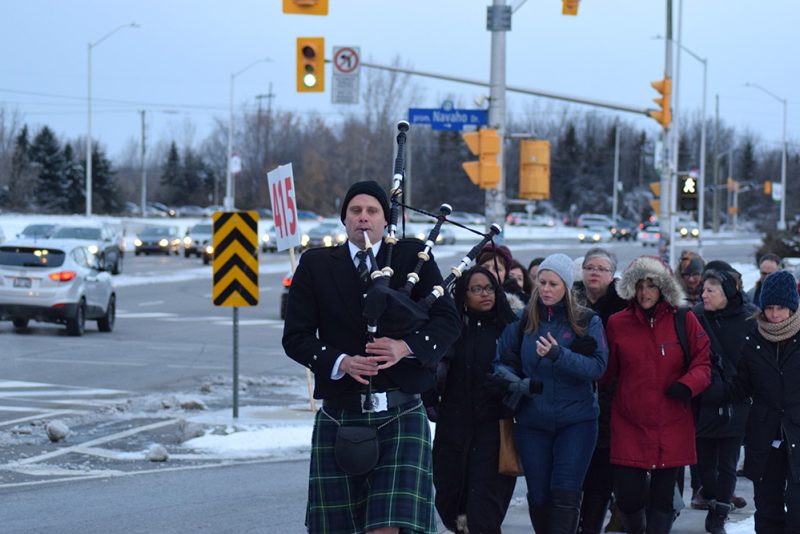Algonquin faculty marked the end of the longest strike in college history Nov. 20 with a solemn bagpipe-led march back to work.
The temperature was at a low of minus nine degrees with the ear-freezing wind chill as members of Algonquin’s union local 415 gathered at the Navaho Drive entrance by Chances R around 7:15 a.m. After waiting about five minutes for more to show up, they started off along Navaho Drive, then Woodroffe Avenue to end at the entrance of C-building.
Faculty will spend Monday catching up and planning out the rest of the semester and classes resumed their regular schedule the following day.
The full impact of the strike will likely not be known for some time, but the college has announced some changes:
– The fall semester will be extended to Jan. 11 for most programs;
– Final exam week from Dec. 9 to 16 is canceled and will be used for classes instead;
– The college will still be closed from the end of the day on Dec. 22 to Jan. 1 for the holidays;
– The withdrawal deadline has been extended to Dec. 15 and the province said students will receive a full refund if they do so because of the strike.
– Winter semester fees are now due Dec. 8 and may be deferred to Feb. 12.
More information on the college’s policy changes can be found at algonquincollege.com/strikeinfo.
The province has also required colleges to establish a student hardship fund from the savings the college gained from not paying striking faculty. That will allow students to receive up to $500 for unexpected costs incurred during the strike. Applications for funding can be made through individual colleges starting this week.
“I’m glad that the strike is over,” said Vladilena Kipriyanova, a student in the four-year interior design bachelor degree program. She said she was happy to be going back to class.
“At the same time I’m frustrated, I don’t know how they’re going to compensate for five weeks lost,” she said.
She was also stressed because she had already made plans to travel to her home in Yakustk, Russia – a lengthy journey which she said involved four flights and one train.
The college has said that situations where students have made travel plans will be dealt with on a case-by-case basis. Kipriyanova said she’s hoping to be able to take her exams at another time in order to visit her family for the holidays.

The strike began at 12:01 a.m. on Oct. 16, after talks between the union and the colleges’ bargaining agent broke up. Despite more negotiations held after the strike began, both parties were still unable to come to an agreement and the province introduced back-to-work legislation on Nov. 16, which passed on Sunday, Nov. 19, following a four-day filibuster by the New Democrats.
Now with teachers back in the classroom, outstanding issues will be dealt with by a neutral third-party official, to be agreed upon by the colleges and union. The official who is appointed will help the parties resolve their issues through mediation, but will also be empowered to use binding arbitration to make a final decision on a settlement.
There has been agreement on some topics, namely the union’s key issue of faculty complement. Although the original demand was to establish a 50:50 ratio of full-time to contract faculty at each college, the two parties agreed instead to let a provincial task force look at that and other issues in the college sector.
The last outstanding issue according to both sides is academic freedom. The union says faculty need more freedom to make decisions about their classes and how to teach them, while management says the union is gunning to take total control and lock out managers from decision-making.
“I think mixed emotions,” said Jack Wilson, first vice-president of OPSEU 415 on the feeling now that the 36-day strike has ended. “Happy to be back with our students, disappointed we couldn’t get a negotiated settlement.”
The last strike in 2006, which lasted 21 days, ended also in mediation-arbitration and a task force but instead of the government passing back-to-work legislation, the union agreed to suspend the strike.
But Jack Wilson said the union was left in the lurch after the 2006 strike ended.
“The momentum of ’06 was lost,” he said. While the union was happy at first, he said when it came time to negotiate a new collective agreement in 2009 the College Employer Council repudiated the task force’s recommendations.
Because it was just a year after the 2008 recession began, there was little appetite for a strike and so members voted against having one, Wilson said.
The 2017 strike is only the second college strike to end with back-to-work legislation. The 1984, which lasted 27 days, was the first.


